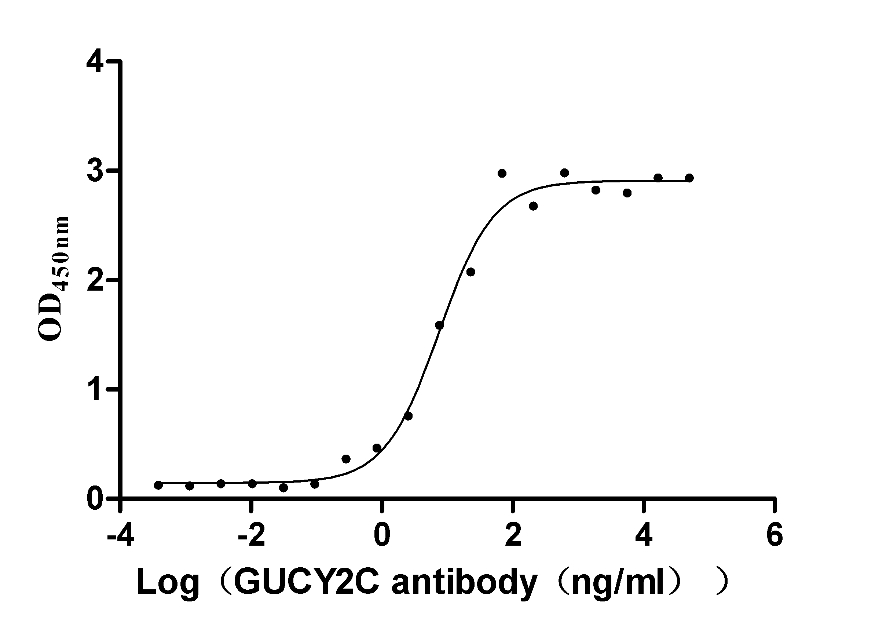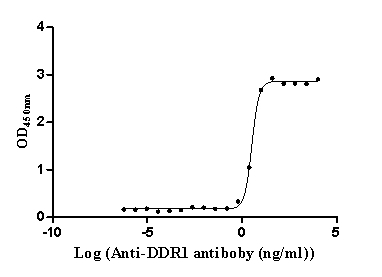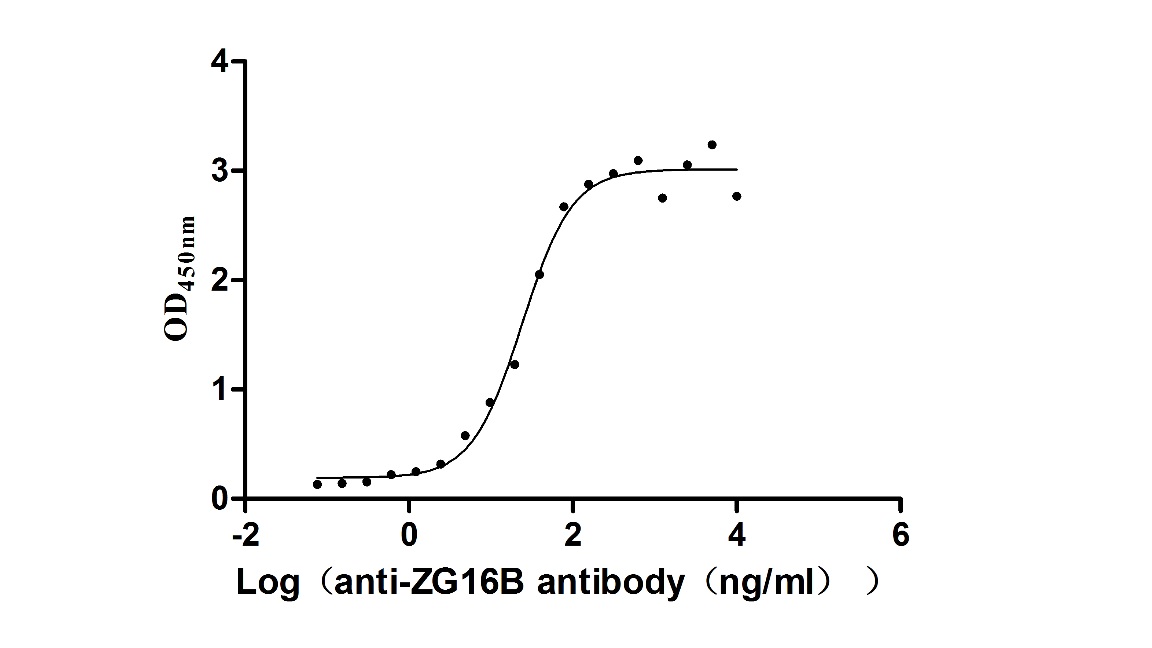Recombinant Human Forkhead box protein E3 (FOXE3)
-
货号:CSB-YP618775HU
-
规格:
-
来源:Yeast
-
其他:
-
货号:CSB-EP618775HU
-
规格:
-
来源:E.coli
-
其他:
-
货号:CSB-EP618775HU-B
-
规格:
-
来源:E.coli
-
共轭:Avi-tag Biotinylated
E. coli biotin ligase (BirA) is highly specific in covalently attaching biotin to the 15 amino acid AviTag peptide. This recombinant protein was biotinylated in vivo by AviTag-BirA technology, which method is BriA catalyzes amide linkage between the biotin and the specific lysine of the AviTag.
-
其他:
-
货号:CSB-BP618775HU
-
规格:
-
来源:Baculovirus
-
其他:
-
货号:CSB-MP618775HU
-
规格:
-
来源:Mammalian cell
-
其他:
产品详情
-
纯度:>85% (SDS-PAGE)
-
基因名:FOXE3
-
Uniprot No.:
-
别名:Drosphilia Forkhead Homolog Like 12; FKHL 12; FKHL12; Forkhead Box E3; Forkhead box protein E3; Forkhead Related Activator 8; Forkhead related protein FKHL12; Forkhead-related protein FKHL12; Forkhead-related transcription factor 8; Foxe3; FOXE3 forkhead box E3 ; FOXE3_HUMAN; FREAC 8; FREAC-8; FREAC8
-
种属:Homo sapiens (Human)
-
蛋白长度:full length protein
-
表达区域:1-319
-
氨基酸序列MAGRSDMDPP AAFSGFPALP AVAPSGPPPS PLAGAEPGRE PEEAAAGRGE AAPTPAPGPG RRRRRPLQRG KPPYSYIALI AMALAHAPGR RLTLAAIYRF ITERFAFYRD SPRKWQNSIR HNLTLNDCFV KVPREPGNPG KGNYWTLDPA AADMFDNGSF LRRRKRFKRA ELPAHAAAAP GPPLPFPYAP YAPAPGPALL VPPPSAGPGP SPPARLFSVD SLVNLQPELA GLGAPEPPCC AAPDAAAAAF PPCAAAASPP LYSQVPDRLV LPATRPGPGP LPAEPLLALA GPAAALGPLS PGEAYLRQPG FASGLERYL
-
蛋白标签:Tag type will be determined during the manufacturing process.
The tag type will be determined during production process. If you have specified tag type, please tell us and we will develop the specified tag preferentially. -
产品提供形式:Lyophilized powder
Note: We will preferentially ship the format that we have in stock, however, if you have any special requirement for the format, please remark your requirement when placing the order, we will prepare according to your demand. -
复溶:We recommend that this vial be briefly centrifuged prior to opening to bring the contents to the bottom. Please reconstitute protein in deionized sterile water to a concentration of 0.1-1.0 mg/mL.We recommend to add 5-50% of glycerol (final concentration) and aliquot for long-term storage at -20℃/-80℃. Our default final concentration of glycerol is 50%. Customers could use it as reference.
-
储存条件:Store at -20°C/-80°C upon receipt, aliquoting is necessary for mutiple use. Avoid repeated freeze-thaw cycles.
-
保质期:The shelf life is related to many factors, storage state, buffer ingredients, storage temperature and the stability of the protein itself.
Generally, the shelf life of liquid form is 6 months at -20°C/-80°C. The shelf life of lyophilized form is 12 months at -20°C/-80°C. -
货期:Delivery time may differ from different purchasing way or location, please kindly consult your local distributors for specific delivery time.Note: All of our proteins are default shipped with normal blue ice packs, if you request to ship with dry ice, please communicate with us in advance and extra fees will be charged.
-
注意事项:Repeated freezing and thawing is not recommended. Store working aliquots at 4°C for up to one week.
-
Datasheet :Please contact us to get it.
相关产品
靶点详情
-
功能:Transcription factor that controls lens epithelial cell growth through regulation of proliferation, apoptosis and cell cycle. During lens development, controls the ratio of the lens fiber cells to the cells of the anterior lens epithelium by regulating the rate of proliferation and differentiation. Controls lens vesicle closure and subsequent separation of the lens vesicle from ectoderm. Controls the expression of DNAJB1 in a pathway that is crucial for the development of the anterior segment of the eye.
-
基因功能参考文献:
- The sclerocornea-microphthalmia-aphakia complex is a severe malformative ocular phenotype resulting from mutations in the FOXE3 transcription factor. To date, patients from at least 14 families with this uncommon ocular disorder have been described. The identification of 2 novel pathogenic variants in our patients expands the mutational spectrum in FOXE3-related congenital eye disorders. PMID: 29878917
- Data show that DnaJ (Hsp40) homolog, subfamily B, member 1 (DNAJB1) is a transcriptional target of forkhead box protein E3 (FOXE3) in a pathway that is crucial for the development of the anterior segment of the eye. PMID: 27218149
- Although congenital aphakia is known to be caused by mutations in the FOXE3 gene, the results of lack of coding mutation in this patient suggests a possible genetic heterogeneity of the disease. PMID: 28805541
- Only one novel missense mutation in exon 1 of FOXE3 (Chr1:47,882,459, c.472G>C, p.Gly158Arg) was identified being homozygous in the three affected and heterozygous in the two unaffected, which was confirmed by Sanger sequencing. PMID: 27669367
- FOXE3 mutations lead to a reduced number of aortic smooth muscle cells (SMCs) during development and increased SMC apoptosis in the ascending aorta in response to increased biomechanical forces. PMID: 26854927
- This is the first functional evidence demonstrating that FOXE3 mutations identified in patients impair protein function with differential effects. PMID: 25504734
- Our results indicate that the FOXE3 p.Val201Met allele is associated with eye defects (OR = 3.5), suggesting its involvement as an ocular malformation risk factor. PMID: 24689660
- This study demonstrates that a cluster of patients with sclerocornea, aphakia, and microphthalmia in a small Mexican village is due to a FOXE3 p.Y98H founder mutation. PMID: 24019743
- shRNA-mediated gene silencing of FOXE3 could significantly inhibit cell growth and induce the G1-phase arrest in human lens epithelial cell line-3 cells. PMID: 22527307
- The FOXE3 mutation detected in c.601 G > A, predicting p.Val201Met which were not yet been included in public databases, but has previously been reported in both A/M patients. PMID: 22204637
- Autosomal-dominant mutations within FOXE3 cause anterior segment dysgenesis and has important clinical utility, especially for the diagnosis of mildly affected patients. PMID: 21150893
- Using autoantibodies from systemic sclerosis (SSc) patients, two anti-CENP-A-specific motifs were defined in its immunodominant epitope Ap17-30. One of these motifs matched residues 53-62 of FOXE3, a protein not previously implicated in SSc. PMID: 20630806
- This is the fourth report detailing homozygous FOXE3 mutations causing anterior segment abnormalities in human patients. PMID: 20664696
- Mutations in several transcription factors associated with aniridia and congenital cataract, FOXE3, (PAX6), PITX2, and PITX3 genes, were examined. PMID: 20806047
- FOXE3 is responsible for the early developmental arrest of the lens placode, and the complete loss of a functional FOXE3 protein results in primary aphakia. PMID: 20361012
- Recessive mutations in FOXE3 were found in four of 26 probands affected with bilateral microphthalmia (15% of all bilateral microphthalmia and 100% of consanguineous families with this phenotype). PMID: 20140963
- Role very early in the lens developmental program, perhaps earlier than any role recognized elsewhere for this gene. PMID: 16826526
- findings suggest that mutations in FOXE3 can give rise to a broad spectrum of eye anomalies, largely, but not exclusively related to lens development, and that both dominant and recessive inheritance patterns can be represented PMID: 19708017
- FOXE3 is essential for closure of the lens vesicle during eye development and for lens epithelial survival and proliferation. PMID: 10652278
显示更多
收起更多
-
相关疾病:Anterior segment dysgenesis 2 (ASGD2); Cataract 34, multiple types (CTRCT34); Aortic aneurysm, familial thoracic 11 (AAT11)
-
亚细胞定位:Nucleus.
-
数据库链接:
HGNC: 3808
OMIM: 601094
KEGG: hsa:2301
STRING: 9606.ENSP00000334472
UniGene: Hs.112968
Most popular with customers
-
Recombinant Human Glypican-3 (GPC3) (G537R), partial (Active)
Express system: Mammalian cell
Species: Homo sapiens (Human)
-
Recombinant Human Heat-stable enterotoxin receptor (GUCY2C), partial (Active)
Express system: Mammalian cell
Species: Homo sapiens (Human)
-
Recombinant Macaca mulatta Semaphorin-4D isoform 1 (SEMA4D), partial (Active)
Express system: Mammalian cell
Species: Macaca mulatta (Rhesus macaque)
-
Express system: Mammalian cell
Species: Homo sapiens (Human)
-
Recombinant Human Epithelial discoidin domain-containing receptor 1 (DDR1), partial (Active)
Express system: Mammalian cell
Species: Homo sapiens (Human)
-
Recombinant Macaca fascicularis Membrane spanning 4-domains A1 (MS4A1)-VLPs (Active)
Express system: Mammalian cell
Species: Macaca fascicularis (Crab-eating macaque) (Cynomolgus monkey)
-
Recombinant Human Tumor-associated calcium signal transducer 2 (TACSTD2), partial (Active)
Express system: Mammalian cell
Species: Homo sapiens (Human)
-
Recombinant Macaca fascicularis zymogen granule protein 16 homolog B (ZG16B) (Active)
Express system: Mammalian cell
Species: Macaca fascicularis (Crab-eating macaque) (Cynomolgus monkey)


-AC1.jpg)

















